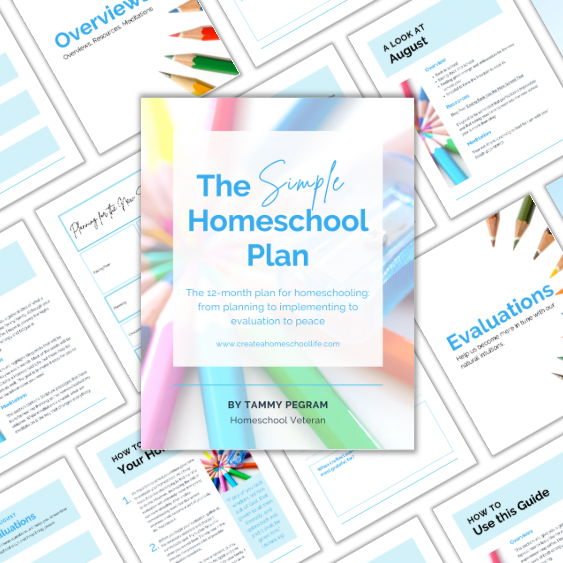A Beginner’s Guide to Homeschooling
The Need
Have you ever seen a need and thought, “I wonder if I could help with that?
Heartbreakingly, there is a scenario I often see playing out.
It usually begins with the new homeschool mom who is worried, frantic, and scared, saying, “I want to homeschool my child, but… I don’t know where to start, I don’t know how, or I don’t know (fill in the blank).”
The truth is, it is overwhelming when beginning to homeschool. Not to mention considering all the essential things that go with it. It is completely normal not to know where to start. As moms, our love for our children creates instinctive desperation to get it right. I understand! Really I do!
The Friend
Wouldn’t it be great to have a friend who has already walked the path before you? A friend who can lead you to the best parts of the journey and help you through the rough patches?
With this in mind, I wondered, could I write a helpful guide? So, in a way, I can be a friend who takes you by the hand and points you in the right direction. While at the same time, write it in a way you can go through it at your own pace in your own time. Perhaps call it a beginner’s guide to homeschooling. Hmm,,,
So, while imagining talking to my baby sister, I have written this crazy long post. I hope you feel the love in it. To make it easier to navigate, I’ve included a table of contents, an infographic, and a printable worksheet. Feel free to bookmark this page or save it on Pinterest so you can take your time or read it later. My prayer is that by the end of this post, you will feel empowered with a practical plan to begin creating a homeschool life.
You can do this, my friend!! Enjoy!
Tip: Tap any content in the table of contents and jump to that spot in the post. Isn’t technology grand? 🙂
Disclosure: This post may contain affiliate links, which means I may receive a small commission, at no extra cost to you, if you make a purchase using this link. Please see my disclosure for more details.
What is Homeschooling?
Homeschooling is what it sounds like. It is schooling or educating a child at home.
However, homeschooling is not attempting to bring the school in the traditional brick-and-mortar school day into our home. There’s no need to buy a school desk or have a hall pass. Standing in line training is unnecessary. 🙂
Furthermore, the sooner we embrace all the freedom homeschooling offers and break free of the traditional way of schooling as we know it, the happier everyone in the home will be. The mom, the dad, the kids, yes, everyone will be happier.
Why Choose Homeschooling?
Homeschooling is an excellent choice for education because it empowers parents to educate their children in ways that fit them best.
Additionally, homeschooling enables children to sharpen skills or specialize in areas they love and study subjects they are passionate about. At the same time, allowing them to focus on their weaknesses in the loving comfort of family and the privacy of home. In essence, with homeschooling, we can celebrate our children where they are and be in the best position to cheer them forward.
10 Steps to Start Homeschooling


1. Establish Your “Why”
This will evolve over time, but establishing your “why” is the best place to start, like most new things in life. When faced with this opportunity, I often find it helpful to ask myself questions. The answers equip me with the information I need to make wise decisions. Here are a few questions to help you get started.
- Do you want to provide a learning environment for your child that is stress-free, bully-free, and comparison-free?
- Do you desire to choose the curriculum your child will use, so you know they are getting the best possible fit for them?
- Do you want to control the content of your curriculum, so they are not confused by varying worldviews before being given a proper foundation?
- Do you desire to instill in your child a love of learning that will stay with them for a lifetime?
For my husband and I, our “why” began as a simple desire to teach our child to read before sending him to “real school.” That one year turned into two, which turned into graduation finally. 🙂
Before we go on, If you would like a little more on this step, read this post Finding Your “Why” in Homeschooling; in it I’ve outlined 5 Steps to Finding Your “Why”


2. Find Out Your State Law for Homeschooling
Next, find out your state law for homeschooling. Please don’t forget this crucial step. Remember, every state has different laws on homeschooling. I recommend the HSLDA (Homeschool Legal Defense Association) website. They have all the state laws listed and can help if you ever encounter any problems.
Be encouraged, homeschooling has come a long way, and it’s not nearly as hard to homeschool today as it once was.


3. Discover All the Different Approaches to Homeschooling
After becoming aware of your state laws, it’s time to discover all the different approaches to homeschooling. There are as many different ways to homeschool as there are families and one of the many reasons why I love homeschooling! There is a path that will benefit your family. Here are a few approaches to get you started:
- Classical
- Traditional
- Charlotte Mason
- Unschooling
- Eclectic
Most homeschoolers are a bit of a mix of these and many others.
Taking a little time to discover the different approaches can open up a whole new world of opportunities for you and your family.
Don’t stress out. Have fun with this step, and let it inspire you!


4. Know yourself
Next, it is a good idea to get to know yourself as a homeschool mom. How do you know what will be a good fit for you? It’s helpful to think about yourself. As a new homeschool mom, this step surprised me, and I find it often surprises other new homeschool moms as well.
The idea is to understand what you need as a teaching mom. Questions help with discovery here too.
- What kind of teacher are you?
- Do you enjoy talking with your kids for hours on end?
- Or are you a bit of an introvert?
- Do you like being hands-on?
- Or would you prefer someone else to guide your child through independent reading?
- Do you enjoy spontaneous learning and chasing down rabbits through rabbit holes?
- Or do you prefer everything well laid out and scripted?


5. Know Your Child
After you take some time to think about what kind of teacher you are and how you like to teach, now is the time to think about your child.
- Are they always moving?
- Do they like lots of quiet play?
- Do they want mom 24/7?


6. Decide on Goals
- Where is your little one?
- Is it time to learn to read?
- Is there a struggle with math facts?
- Is high school on the horizon?
- Is there a passion in which your child wants to invest?
All of us have strengths and weaknesses. Homeschooling allows you to ask the right questions and craft goals for your child’s specific needs.


7. Decide on Your Curriculum
You can now make wise decisions on your curriculum by taking all the information you have learned so far. Some will be teacher intensive, some not so much.
Knowing yourself, your child, your needs, and your goals will help you choose the right resource for you and your family.
For more information on choosing your curriculum including how I decide what to use and where I’ve purchased our curriculum for almost 20 years, I invite you to read this post: 5 Tips to Choosing Your Homeschooling Curriculum.


8. Plan Your Year
- When will you start?
- When will you take breaks?
- Will you homeschool all year or follow the local school system?
We’ve done both. I prefer year-round homeschooling. It allows for more relaxed days and no rushing to get through. As our kids grow, there are years when they express their desire to take off the same weeks as their friends in the neighborhood. We go back and forth as needed.
“Remembering to follow the rhythm of my family is one of my secrets to happy homeschool days.” 😉
Would you like more insight on this step? Here is a post dedicated to planning your homeschool year. It’s an important step that can be intimidating initially, but it doesn’t have to be. It can actually be a lot of fun. You’ll see.
While we are on the topic of planning, do you need any planning pages? I’ve got you covered with free printables right here 🙂


9. Choose a Support Team
- What kind of support do YOU need?
- A friend you can talk to and bounce ideas off?
- A group with activities?
- A book?
- A blog? 😉
My husband and my faith have been my greatest support as a homeschooling mom. What works best for me is to pray first and then bounce ideas off my husband. Because so often, he can see plainly what I can’t see and helps me simplify things that I tend to overcomplicate.
I have also found that seeking out older moms who “have been there and done that” helped me trust the process, which brings us to the next step.


10. Learn to Trust the Process
Finally, learn to trust the process. Deciding to homeschool is a huge burden because it is terrifying in the beginning! I get it! You are taking all the responsibility of educating your child on yourself, and if it doesn’t turn out as you hope, there is no one else to blame. It can cause us to want to freak out at every missed math problem and failed science experiment.
But the truth is: No one loves your child more than you do. No one has more invested interest in seeing your child succeed than you do. The fact that you agonize over what you believe to be the best for them qualifies you.


If you would like a printable version of the 10 Steps to Start Homeschooling just tap the image below to subscribe!
Tips for Success in Homeschooling
Evaluate Along the Way
Plan your year, but school daily, evaluating all along the way. Homeschooling doesn’t allow for a “set it and forget it” mentality. Ask me how I know. That’s right. Because just when you think your child is completely independent, you’ll realize that the book you gave them to read, well, they lost it. Or ran out of time, forgot, or some such random but totally normal kid excuse.
It’s not all that different from other mom stuff. We evaluate our households all the time. Don’t believe me? Let’s take a little quiz and see how you fare.
Do you?
- Do you know when your children need more sleep?
- Do you watch their eating habits?
- Do you notice when they need new clothes because they are outgrowing the ones they have?
- Do you pay attention to the emotional needs of your children?
- Do you see when they need more one-on-one time with Mom or Dad?
Of course, you do! You’re a mom! And just like you care for them in every other area of life, YOU ARE well able to do this too. 😊
Use Your Support Team
Yes, please use it. So often, we attempt to do all our “mom stuff” alone. Instead, try talking to God and sharing your heart with him. Ask for wisdom. Talk to your spouse. Read books. Reach out. You don’t have to go it alone.
Invest in Yourself
When it comes to tips for homeschooling, I can’t stress this one enough. Don’t forget to take care of yourself. Yes, YOU. It doesn’t do anyone any good for you to give away every bit of yourself and have nothing left. Eventually, you will hit a wall. As hard as it is to find time, it’s worth it to invest in yourself now before that happens. It doesn’t have to be expensive or time-consuming, just some way that fills you. Everyone you love will benefit when you take care of “you.”
Frequently Asked Questions
The Last Things You Need to Know About Homeschooling
There Will Be Sacrifices
Indeed, homeschooling is one of the greatest sacrifices you can make for your child. You will have good days, and you most definitely will have bad days. There will be times when you think you have everything all figured out, only to find you must start all over.
Likewise, there will be times when you will be elated by your child’s progress and other times disappointed.
It’s Worth It
But in the end, when it’s all said and done, and you are watching your graduate receive his diploma, As he moves his tassel from one side of his cap to the other, you will agree this was a most rewarding experience you wouldn’t trade for anything.
You’ll Never Stop Learning
The last thing you need to know about homeschooling is you will forever be learning, evolving, and changing. What you think you can’t do right now you will do with ease in time, and then you’ll be the one who reaches back to help another brand new homeschooling mom. It is truly one of the best decisions ever!!
You CAN do this!
Much Love, ~Tammy


This post was originally published on May 16, 2022, and has been updated for accuracy and comprehensiveness.








